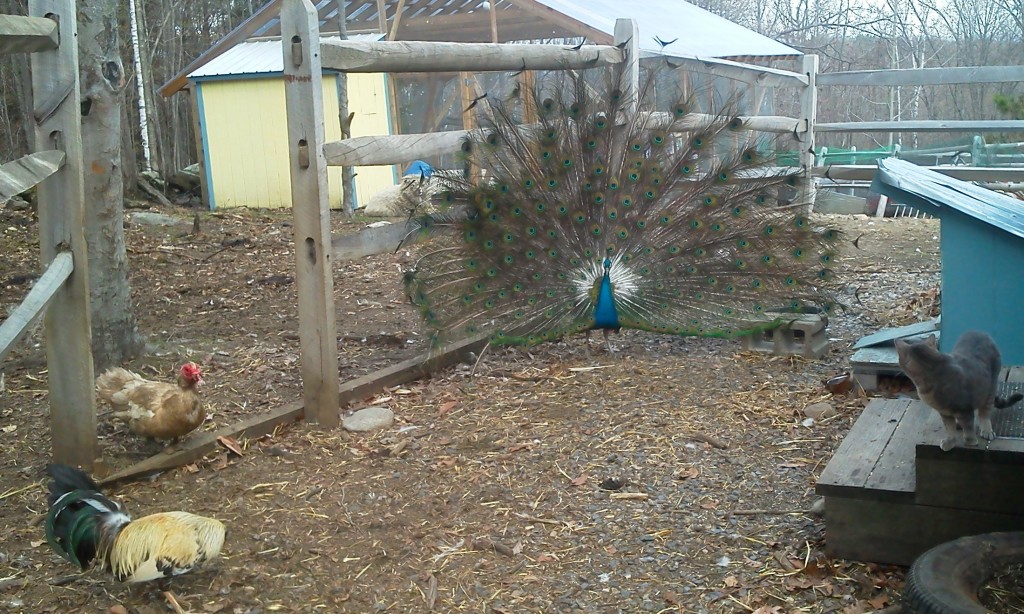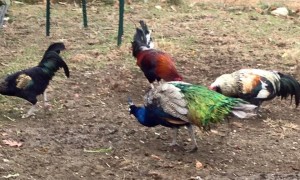by pattrice jones. Reprinted from an issue of Versus magazine devoted to vegan style.
Here at VINE Sanctuary, the peacock called Rocky likes to display his fabulous tail feathers to a rooster called Sharkey. Of course, we cannot be certain what he intends by this gesture, but Rocky seems to be courting or trying to attract Sharkey — obviously not for reproductive purposes.
 Rocky displays for Sharkey as Churchill the duck and Zaso the cat look on.
Rocky displays for Sharkey as Churchill the duck and Zaso the cat look on.
Speciesist discourse explains every animal behavior by way of reproduction, as if animals were automatons mindlessly intent on getting their genes into the next generation. This grim and falsely “reprocentric” conception of nature contributes to the subordination of both LGBTQ people and nonhuman animals.
University of British Columbia biologist and linguist Bruce Bagemihl proposes that we see same-sex affection, coupling, and courtship displays among nonhuman animals as “biological exuberance” — a function of the surplus energy that shines down from the sun every day. When male griffon vultures soar together in the pair bonding display called tandem flying, riding thermal currents one atop the other, this reflects the abundance of energy and creativity that is life.
I see style in the same way. When we paint our walls pretty colors, just for the fun of it, or when we adorn ourselves with scents and sparkling objects likely to bring pleasure to others, we realize our own animal gifts for generosity, superfluous creativity, and purposeless joy.
That’s beautiful, yes? But consider this: The only parrots native to eastern North America, Carolina parakeets, were driven to extinction by consumer demand for their colorful feathers, with which stylish people decorated their hats. Replacing feathers with vegan equivalents does not solve all of the problems with what might be called the ugly side of style, which emerges when our animal instincts for beauty, pleasure, and communion express themselves in the context of elitism and capitalism.
-

- Bright feathers have led many birds to become actual fashion victims
Capitalism began with captive cattle, the heads (or capita) of whom were the original capital. The mathematics of this inherently hurtful economic system require more and more consumers to buy more and more things. This is, of course, destroying the planet upon which all animals depend. In order to fuel consumption, capitalism promotes style. Advertisers convince people that embellishments are necessities and encourage people to display elite status by means of stylish purchases.
Style serves not only as a means of self-expression but also as a marker of group membership. As social animals, we sometimes use style to place ourselves in one or another social group. This may be inoffensive or even valorous, as when people flaunt rather than hide signs of their membership in a denigrated group, but styles meant to signal group membership very often are colored by cliquishness or conceit. When the group in question is a high-status group such as an economic elite, style serves to exclude rather than embrace.
And so we can begin to see the two sides of style: On the one hand, nourishing joy abides in the flourish, the gesture performed only because it is beautiful. On the other hand, danger lurks within the empty commodity, especially if it serves as a symbol of membership in some sort of elite.
This tension within style becomes even more evident when one thinks about vegan style.
As more and more companies, large and small, begin to court vegan customers, I’ve become increasingly worried about what I call “commodity veganism” — a way of being vegan that focuses on and fetishizes vegan products, including not only foodstuffs but also clothing and adornments. I’ve also grown alarmed by the self-regard implicit in the idea that veganism is an identity rather than a practice. Those concerns collide when I imagine people purchasing expensive products that in some way showcase their identities as vegans.
On the other hand, I love the idea of people from many different stylistic communities not only figuring out how to “veganize” their wardrobes and furnishings but also finding ways to display the joys of plant-based living to their peers. I’m also interested in efforts to show that full-on veganism (by which I mean rejection of any product that exploits any animal —human or nonhuman— along with an ecological commitment to reduce, reuse, and recycle) can coincide with boisterous beauty.
Let’s all embrace the ethos of exuberance and generosity that Rocky demonstrates whenever he displays his fine feathers to the whole wide world. That, to me, would be truly vegan style.
This essay was originally published in the Canadian magazine Versus, to which you should subscribe if you read French and enjoy ideas. If you wish to share or read the French version of this essay, you can find it here.
Peacocks, Parakeets, and the Two Sides of Style
by pattrice jones. Reprinted from an issue of Versus magazine devoted to vegan style.
Here at VINE Sanctuary, the peacock called Rocky likes to display his fabulous tail feathers to a rooster called Sharkey. Of course, we cannot be certain what he intends by this gesture, but Rocky seems to be courting or trying to attract Sharkey — obviously not for reproductive purposes.
Speciesist discourse explains every animal behavior by way of reproduction, as if animals were automatons mindlessly intent on getting their genes into the next generation. This grim and falsely “reprocentric” conception of nature contributes to the subordination of both LGBTQ people and nonhuman animals.
University of British Columbia biologist and linguist Bruce Bagemihl proposes that we see same-sex affection, coupling, and courtship displays among nonhuman animals as “biological exuberance” — a function of the surplus energy that shines down from the sun every day. When male griffon vultures soar together in the pair bonding display called tandem flying, riding thermal currents one atop the other, this reflects the abundance of energy and creativity that is life.
I see style in the same way. When we paint our walls pretty colors, just for the fun of it, or when we adorn ourselves with scents and sparkling objects likely to bring pleasure to others, we realize our own animal gifts for generosity, superfluous creativity, and purposeless joy.
That’s beautiful, yes? But consider this: The only parrots native to eastern North America, Carolina parakeets, were driven to extinction by consumer demand for their colorful feathers, with which stylish people decorated their hats. Replacing feathers with vegan equivalents does not solve all of the problems with what might be called the ugly side of style, which emerges when our animal instincts for beauty, pleasure, and communion express themselves in the context of elitism and capitalism.
Capitalism began with captive cattle, the heads (or capita) of whom were the original capital. The mathematics of this inherently hurtful economic system require more and more consumers to buy more and more things. This is, of course, destroying the planet upon which all animals depend. In order to fuel consumption, capitalism promotes style. Advertisers convince people that embellishments are necessities and encourage people to display elite status by means of stylish purchases.
Style serves not only as a means of self-expression but also as a marker of group membership. As social animals, we sometimes use style to place ourselves in one or another social group. This may be inoffensive or even valorous, as when people flaunt rather than hide signs of their membership in a denigrated group, but styles meant to signal group membership very often are colored by cliquishness or conceit. When the group in question is a high-status group such as an economic elite, style serves to exclude rather than embrace.
And so we can begin to see the two sides of style: On the one hand, nourishing joy abides in the flourish, the gesture performed only because it is beautiful. On the other hand, danger lurks within the empty commodity, especially if it serves as a symbol of membership in some sort of elite.
This tension within style becomes even more evident when one thinks about vegan style.
As more and more companies, large and small, begin to court vegan customers, I’ve become increasingly worried about what I call “commodity veganism” — a way of being vegan that focuses on and fetishizes vegan products, including not only foodstuffs but also clothing and adornments. I’ve also grown alarmed by the self-regard implicit in the idea that veganism is an identity rather than a practice. Those concerns collide when I imagine people purchasing expensive products that in some way showcase their identities as vegans.
On the other hand, I love the idea of people from many different stylistic communities not only figuring out how to “veganize” their wardrobes and furnishings but also finding ways to display the joys of plant-based living to their peers. I’m also interested in efforts to show that full-on veganism (by which I mean rejection of any product that exploits any animal —human or nonhuman— along with an ecological commitment to reduce, reuse, and recycle) can coincide with boisterous beauty.
Let’s all embrace the ethos of exuberance and generosity that Rocky demonstrates whenever he displays his fine feathers to the whole wide world. That, to me, would be truly vegan style.
This essay was originally published in the Canadian magazine Versus, to which you should subscribe if you read French and enjoy ideas. If you wish to share or read the French version of this essay, you can find it here.